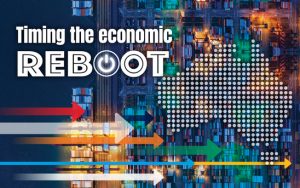
Global comparison
Economic forecasts are difficult at the best of times, but especially now when so much hinges on how quickly and safely we and the rest of the world can kick start our economies. The International Monetary Fund (IMF) is forecasting the world economy to shrink by 3 per cent this year. To put this in perspective, even during the GFC the contraction was only 0.1 per cent in 2009. In Australia, the government forecasts growth will fall by 10 per cent in the June quarter, our biggest fall on record. If we manage a gradual economic reboot, with most activity back to normal by the September quarter, the Reserve Bank forecasts a fall in growth of 6 per cent this year before rebounding by 7 per cent in the year to June 2021.i Even if we pull off this relatively fast return to growth, it will take much longer to repair the budget.Budget repair
Economists have recently reduced their forecasts for the budget deficit after the JobKeeper wage subsidy program came in $60 billion under budget. However, they are still predicting our debt and deficits will reach levels not seen since World War II. For example, Westpac chief economist, Bill Evans forecasts a budget deficit of $80 billion this year and $170 billion next year. AMP’s Dr Shane Oliver also expects the deficit to peak at $170 billion next financial year.iiAustralian Federal budget deficit

Source: AMP
While polling shows most Australians approve of the way the federal and state governments have handled the crisis, many are beginning to wonder how we as a nation are going to pay for it. The key to recovery will be getting Australians back to work; for those who have had their hours cut to return to full-time work, and those who have lost jobs to find work.It’s all about jobs
The unemployment rate is forecast to double to 10 per cent, or 1.4 million people, in the June quarter with total hours worked falling 20 per cent After the June 2020 peak, the Reserve Bank expects a gradual fall in the annual unemployment rate to around 6.5 per cent by June 2022. This is still above pre-pandemic levels of around 5.2 per cent.i With the government announcing the easing of restrictions on movement in three stages by July, Treasury estimates 850,000 people would be able to return to work. More than half of these workers would be in three sectors – accommodation and food; arts and recreation; and transport, postal and warehousing. Treasury also estimates that this easing of restrictions will increase economic growth by $9.4 billion a month. However, this outcome depends on us following the health advice. The cost of re-imposing restrictions could come at a loss of more than $4 billion a week to the economy. The stakes are highest for our two most populous states. The cost of re-imposing restrictions could amount to $1.4 billion a week in NSW and $1 billion a week in Victoria. This provides an insight into why those states have moved more cautiously than others in reopening some sectors of their economies.The growth strategy
Looking ahead, Treasurer Frydenberg said the government’s focus will be on ‘’practical solutions”, citing existing policies such as reskilling and upskilling the workforce, maintaining our infrastructure pipeline, cutting red tape and tax and industrial relations reform. The Treasurer also made it clear he expects the private sector to lead job creation, not government. If the past few months are anything to go by, Australians have risen to the challenge. From working from home and staying connected via Zoom, to restaurants pivoting from dine-in to takeaway and manufacturers switching to production of ventilators and hand sanitiser, individuals and businesses have been quick to adapt and innovate. This is likely to be one of the positive legacies of the pandemic and should help our economic recovery in the years to come. If you would like to discuss your finances and how to make the most of the recovery, give us a call.i https://www.rba.gov.au/publications/smp/2020/may/economic-outlook.html
ii https://www.amp.com.au/insights/grow-my-wealth/the-coming-surge-in-australias-budget-deficit-and-public-debt Unless otherwise stated, figures have been sourced from Treasurer Josh Frydenberg’s “The economic impact of the crisis” statement https://ministers.treasury.gov.au/ministers/josh-frydenberg-2018/speeches/ministerial-statement-economy-parliament-house-canberra